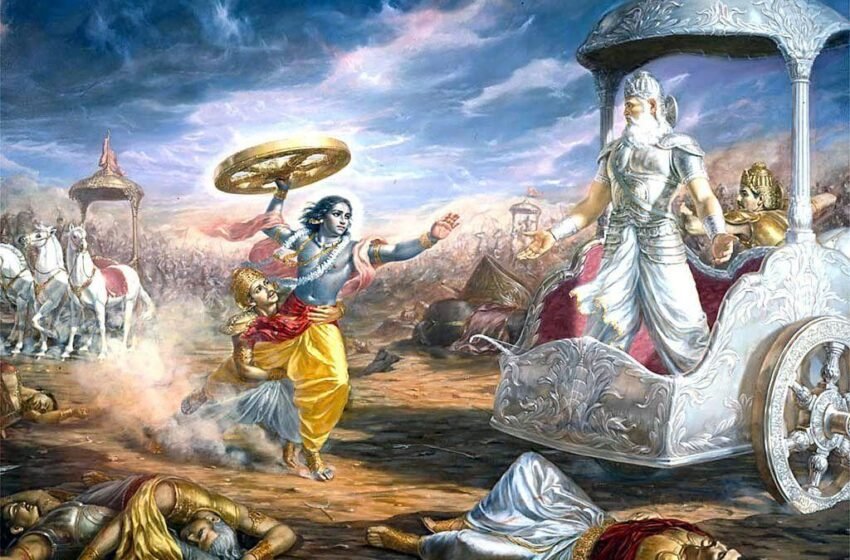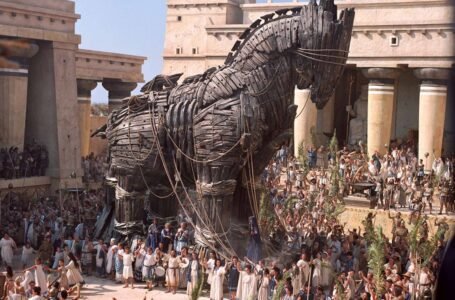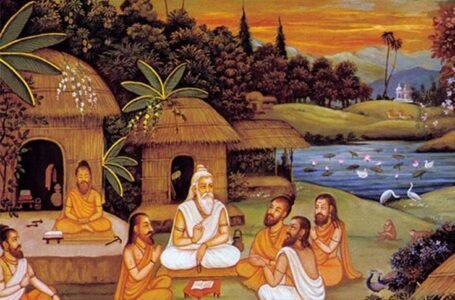The Mahabharata War: Between Myth and Memory – Tracing the Historical Roots of an Epic Conflict

-Ananya Sinha
Mahabharata is one of the greatest achievements of world literature such an epic on a phenomenal scale that it goes beyond mere narration to integrate myth, philosophy, history, and moral exploration. Its core is the Kurukshetra War, a battle whose reverberations have run through centuries in Indian cultural memory. But questions remain: Was the war a real historic event, or a mythological fiction that developed from centuries of oral tradition? Did it occur in a particular time and location, or is it an allegorical fabric woven to represent eternal human conflicts? Unraveling the historical origins of the Mahabharata War requires one to venture into archaeology, ancient texts, linguistic studies, and cultural memory.
The Epic as a Cultural Monument
The Mahabharata is more than a war epic; it is an encyclopedia of civilisation. Covering over 100,000 lines, it includes the Bhagavad Gita, teachings on statecraft (Shanti Parva), cosmology, and ethics. The Kurukshetra War, which occupies the eighteenth book (Bhishma Parva onwards), is a dynastic conflict between the Pandavas and the Kauravas, yet it is also a cosmic war between dharma and adharma.
The war tale has several layers—genealogical accounts of royal lineages, accurate battlefield geography, and elaborate descriptions of battle formations. These lend the epic a whiff of historicity, positing that it could be preserving pieces of real events, even as they are enveloped in mythic grandeur.
Dating the Mahabharata War – Ancient Chronologies
Classic Indian scholars, based on astronomical references in the epic, have suggested dates from 3102 BCE (the beginning of the Kali Yuga in traditional Hindu dating) to approximately 1400 BCE. For example:
Astronomical Calculations: Descriptions of planetary positions prior to the war—e.g., Saturn in the vicinity of Rohini and Mars retrograde close to Jyeshtha—have been utilized by scholars like B.G. Tilak and Raghavan to come up with dates in the late 3rd or early 2nd millennium BCE.
Puranic Genealogies: Vayu Purana and Matsya Purana include king-lists which, if interpreted literally, give the war some centuries ahead of the Buddha, consistent with early Vedic chronology.
However, these conventional datings are disputed since descriptions of the sky can be allegorical rather than factual, and word-of-mouth transmission over centuries might have altered the references.
Archaeological Perspectives
Excavations at places identified with Mahabharata sites—most notably Hastinapur in the state of Uttar Pradesh in modern times—have produced interesting but inconclusive evidence.
Hastinapur Excavations (B.B. Lal, 1950s): Excavators found a flood layer of approximately 800 BCE, which corresponds with subsequent Puranic accounts of Hastinapur’s abandonment because of a Ganges flood. This indicates that part of the city’s memory at least corresponds to geological events.
Painted Grey Ware (PGW) Culture: Dating to around 1200–800 BCE, PGW settlements of Kurukshetra and the surrounding areas demonstrate sophisticated iron weaponry, urbanization, and rice cultivation—features in line with accounts of Mahabharata society.
Archaeology as yet cannot verify a massive war on the scale described in the epic, but it testifies to the possibility of politically advanced societies fighting inter-kingdom wars in the reasonable timeframe.
Oral Tradition and Epic Formation
It is now generally accepted that the Mahabharata developed over several centuries, probably from an early heroic ballad about an actual war, growing and reinterpreted over time through bardic tradition.
Epic Layering: Some scholars, such as John Brockington, contend that the earliest “core” story, perhaps of the late Vedic age (c. 1000–800 BCE), was a war of chieftains in a dispute over succession. Theological, philosophical, and mythological layers accumulated over time.
Cultural Embroidery: The addition of divine interventions (Krishna’s charioteer and strategic role), supernatural weapons (astras), and moral dialogue could have been intended to convert a political dispute into a time-transcending moral allegory.
Therefore, although the proportions of the epic war are overstated, its framework could be based on an historical dynastic dispute.
Geographical Anchors – Mapping Kurukshetra
One of the surprising things about the Mahabharata is its accurate geography. Kurukshetra, “the field of the Kurus,” is recognizable to this day in contemporary Haryana. Towns such as Panipat, Karnal, and Sonipat have names reminiscent of the characters of the epic (Karna, Sona/Suhna, etc.).
Descriptions of rivers such as the Saraswati, Yamuna, and Drishadvati are consistent with the paleo-geography of the late Vedic era. The Saraswati, which was a powerful river flowing across Haryana and Rajasthan, had dried up considerably by 1000 BCE—meaning that the epic retains memories of a topography that existed in past centuries.
Military and Political Context
The described war in the Mahabharata indicates aspects of a transitional period in ancient Indian polity:
Chariot Warfare: The dominance by chariots, and not cavalry, aligns with the late Vedic age, prior to the complete ascendance of mounted horsemen.
Clan Alliances: The long enumeration of joining kingdoms demonstrates the intricate web of relationships and enmities between Janapadas (regional states).
Code of War (Dharma Yuddha): The regulations—no combat after dusk, no assaulting unarmed warriors—while broken in the story, demonstrate early military ethics later debated in Dharmashastra texts.
These aspects indicate the war’s representation, albeit stylized, is based on actual political and military heritage.
Mythologization – Why the War Got Turned into an Epic
Why would a local war get turned into such a gigantic mythic story? There were a number of reasons:
Moral and Philosophical Vehicle: The war became a platform for examining dharma, destiny, and human accountability—issues at the heart of Indian philosophical tradition.
Political Legitimacy: Dynasties claiming descent from Pandavas or Kauravas might invoke divine or heroic legitimacy.
Cultural Unity: Integrating varied traditions, the epic helped tie disparate regions to a common cultural memory.
Didactic Function: The narrative cautioned against unlimited ambition, fratricide, and degradation of moral law.
Parallels in World Epics
The evolution of a likely historical occurrence into a heightened epic is by no means an Indian phenomenon. The Trojan War, perpetuated in the Iliad of Homer, is supposed to have been founded upon an actual war during Late Bronze Age Anatolia and was subsequently mythologized. The Mahabharata war too can be an Indian counterpart—a grain of history embedded in centuries of poetic embellishment.
Modern Scholarly Debate
Scholars are still at variance:
Historical-Realist View: Advocates argue that the war occurred in some form between rival factions in the early Iron Age, with the epic preserving genuine historical memory.
Mythic-Symbolic View: Others contend the war is purely literary, a cosmic allegory of good versus evil, created to embody the eternal struggle for righteousness.
Middle Position: Most modern historians take a middle position, perceiving the Mahabharata as a composite—one ancient battle remembered and reshaped by changing cultural and religious ideals.
Conclusion – Between History and Eternity
The Mahabharata War stands at the intersection of history and legend. Archaeology, textual evidence, and geographical research all seem to suggest that there might have been some true conflict in the Vedic-to-Iron Age period, but its precise nature and scope is beyond proof. However, to look for purely factual history in the Mahabharata is to lose its underlying truth.
The epic is more than a catalog of who fought against whom, but rather a reflection on why human beings wage war, how they struggle with moral dilemmas, and how they inscribe collective memory. Whether the Kurukshetra War actually occurred in the way it was narrated, its continuous presence in Indian consciousness speaks to an underlying historical truth—the truth of human nature, society’s ills, and the search for dharma that is eternal.
Thus, the Mahabharata War is not merely a possible historical occurrence but an immortal cultural reality, a bridge between the realms of myth and memory.


